Investigation of the Mechanical Physical Properties of Fly Ash Modified Magnesium Phosphate Cement Repair Mortar Cured at Varying Temperatures
Abstract
1. Introduction
2. Materials and Methods
2.1. Materials
2.2. Mixture Proportion
2.3. Specimens Preparation
2.4. Experimental Methods
2.4.1. Physical and Mechanical Properties
2.4.2. Interfacial Bonding Strength
2.4.3. Strength Retention Coefficient
2.4.4. The Linear Shrinkage Rate
2.4.5. Micro-Morphology of Hydration Products and Chemical Composition of Raw Materials
3. Results
3.1. Setting Time
3.2. Fluidity
3.3. Mechanical Properties
3.4. Water Resistance
3.5. Interfacial Bonding Strength
3.6. Drying Shrinkage
3.7. SEM Analysis of MPC Cured at 20 °C
4. Conclusions
- (1)
- The setting time of MPC repair mortar with the same fly ash content mixing at 0 °C is longer than that at 20 °C, and the fluidity mixing at 0 °C is lower than that at 20 °C. The setting time of MPC repair mortar decreases with the increase in fly ash content at 20 °C, and decreases first and then increases with the fly ash content at 0 °C. With the increase in fly ash content, the fluidity of MPC repair mortar mixture mixed at 20 °C and 0 °C first increases and then decreases and reaches the maximum when the content of fly ash is 10 wt%.
- (2)
- The compressive strength of MPC cured at 0 °C is obviously lower than that cured at 20 °C, while the flexural strength, strength retention rate, and interfacial bonding strength vary slightly with that cured at 20 °C. Those are not lower than the latter when the content of fly ash is not higher than 10 wt%. Except that the interfacial bonding strength cured at 0 °C decreases with the increase in fly ash content, the above properties of MPC cured at 0 °C and 20 °C increase first and then decreased with the increase in fly ash content. In other words, MPC cured at 0 °C still has appropriate mechanical properties and water resistance.
- (3)
- The linear shrinkage rate of MPC repair mortar cured at 0 °C is higher than that cured at 20 °C because of the difference in curing humidity under the same fly ash content. The linear shrinkage rate of MPC repair mortar cured at 0 °C and 20 °C decreases first and then increases with the increase in fly ash content, which is the lowest when the fly ash content is 15 wt%.
- (4)
- The section of fly ash-modified MPC contains visible struvite, MgO, fly ash particles, and glass beads. The fly ash refines the struvite and increases the compactness of MPC, so its water resistance is improved. Meanwhile, with the increase in fly ash content, the crystallinity and continuity of struvite decrease, which leads to a decrease in its mechanical properties.
Author Contributions
Funding
Institutional Review Board Statement
Informed Consent Statement
Data Availability Statement
Conflicts of Interest
References
- Wang, Y.; Dai, J. Use of magnesia sand for optimal design of high performance magnesium potassium phosphate cement mortar. Constr. Build. Mater. 2017, 153, 385–392. [Google Scholar] [CrossRef]
- Li, T.; Chen, G.; Yang, J.; Chong, L.; Hu, X. Influence of curing conditions on mechanical properties and microstructure of magnesium potassium phosphate cement. Case. Stud. Constr. Mat. 2022, 17, e01264. [Google Scholar] [CrossRef]
- Wang, Y.; Dai, J.; Ding, Z.; Xu, W. Phosphate-based geopolymer: Formation mechanism and thermal stability. Mater. Lett. 2017, 190, 209–212. [Google Scholar] [CrossRef]
- Zhang, Y.; Wang, J.; Li, L.; Ma, C.; Wang, S. Basic properties and mechanism of high activity phosphate-based slurry for dynamic water blocking-A feasibility research. Constr. Build. Mater. 2021, 275, 122040. [Google Scholar] [CrossRef]
- Jia, X.; Li, J.; Wang, P.; Qian, J.; Tang, M. Preparation and mechanical properties of magnesium phosphate cement for rapid construction repair in ice and snow. Constr. Build. Mater. 2019, 229, 116927. [Google Scholar] [CrossRef]
- Xu, B.; Winnefeld, F.; Ma, B.; Rentsch, D.; Lothenbach, B. Influence of aluminum sulfate on properties and hydration of magnesium potassium phosphate cements. Cement. Concrete. Res. 2022, 156, 106788. [Google Scholar] [CrossRef]
- Jin, B.; Chen, L.; Chen, B. Factors assessment of a repair material for brick masonry loaded cracks using magnesium phosphate cement. Constr. Build. Mater. 2020, 252, 119098. [Google Scholar] [CrossRef]
- Hall, D.; Stevens, R.; El-Jazairi, B. The effect of retarders on the microstructure and mechanical properties of magnesia–phosphate cement mortar. Cement. Concrete. Res. 2001, 31, 455–465. [Google Scholar] [CrossRef]
- Jiang, Z.; Qian, C.; Chen, Q. Experimental investigation on the volume stability of magnesium phosphate cement with different types of mineral admixtures. Constr. Build. Mater. 2017, 157, 10–17. [Google Scholar] [CrossRef]
- Seehra, S.; Gupta, S.; Kumar, S. Rapid setting magnesium phosphate cement for quick repair of concrete pavements—Characterisation and durability aspects. Cement. Concrete. Res. 1993, 23, 254–266. [Google Scholar] [CrossRef]
- Yang, Q.; Wu, X. Factors influencing properties of phosphate cement-based binder for rapid repair of concrete. Cement. Concrete. Res. 1999, 29, 389–396. [Google Scholar] [CrossRef]
- Wang, Q.; Qian, J.; Qin, J.; You, C.; Wang, H. Effect of Ambient Temperature on Setting Time and Strength Development of Magnesia-phosphate Cement. J. Chin. Ceram. Soc. 2013, 41, 6. (In Chinese) [Google Scholar]
- You, C.; Qian, J.; Qin, J.; Wang, H.; Wang, Q.; Ye, Z. Effect of early hydration temperature on hydration product and strength development of magnesium phosphate cement (MPC). Cement. Concrete. Res. 2015, 78, 179–189. [Google Scholar] [CrossRef]
- Yang, N.; Shi, C.; Yang, J.; Chang, Y. Research Progresses in Magnesium Phosphate Cement–Based Materials. J. Mater. Civil. Eng. 2014, 26, 04014071. [Google Scholar] [CrossRef]
- Li, Y.; Chen, B. Factors that affect the properties of magnesium phosphate cement. Constr. Build. Mater. 2013, 47, 977–983. [Google Scholar] [CrossRef]
- Popovics, S.; Rajendran, N. Early age properties of magnesium phosphate-based cements under various temperature conditions. In Proceedings of the 66th Annual Meeting of the Transportation Board, Washington, DC, USA, 12–15 January 1987. [Google Scholar]
- Wang, H. Study on the High Performance Magnesia-Phosphate Cement Based Composites; Chongqing University: Chongqing, China, 2006. [Google Scholar]
- Liao, W.; Ma, H.; Sun, H.; Huang, Y.; Wang, Y. Potential large-volume beneficial use of low-grade fly ash in magnesia-phosphate cement based materials. Fuel 2017, 209, 490–497. [Google Scholar] [CrossRef]
- Gardner, L.; Bernal, S.; Walling, S.; Corkhill, C.; Provis, J.; Hyatt, N. Characterisation of magnesium potassium phosphate cements blended with fly ash and ground granulated blast furnace slag. Cement. Concrete. Res. 2015, 74, 78–87. [Google Scholar] [CrossRef]
- Lu, X.; Chen, B. Experimental study of magnesium phosphate cements modified by metakaolin. Constr. Build. Mater. 2016, 123, 719–726. [Google Scholar] [CrossRef]
- Zheng, D.; Ji, T.; Wang, C.; Sun, C.; Lin, X.; Hossain, K. Effect of the combination of fly ash and silica fume on water resistance of Magnesium–Potassium Phosphate Cement. Constr. Build. Mater. 2016, 106, 415–421. [Google Scholar] [CrossRef]
- Xu, B.; Lothenbach, B.; Winnefeld, F. Influence of wollastonite on hydration and properties of magnesium potassium phosphate cements. Cement. Concrete. Res. 2020, 131, 106012. [Google Scholar] [CrossRef]
- Liu, Y.; Qin, Z.; Chen, B. Experimental research on magnesium phosphate cements modified by red mud. Constr. Build. Mater. 2020, 231, 117131. [Google Scholar] [CrossRef]
- Zheng, Y.; Zhou, Y.; Huang, X.; Luo, H. Effect of raw materials and proportion on mechanical properties of magnesium phosphate cement. J. Roa. Eng. 2022, 2, 243–251. [Google Scholar] [CrossRef]
- Jia, X.; Luo, J.; Zhang, W.; Tang, M.; Qian, J.; Wang, P.; Li, J. Reaction characteristics and compressive strength of magnesia-phosphate cement at negative temperatures. Constr. Build. Mater. 2021, 305, 124819. [Google Scholar] [CrossRef]
- Feng, H.; Nie, S.; Guo, A.; Lv, L.; Chu, L.; Yu, J. Fresh properties and compressive strength of MPC-based materials with blended mineral admixtures. Case. Stud. Constr. Mat. 2022, 17, e01201. [Google Scholar] [CrossRef]
- Liu, J.; Li, Z.; Zhang, M.; Hai, R. Research progress on magnesium phosphate cement modified by mineral admixtures. Inorg. Chem. Ind. 2022, 54, 18–23. (In Chinese) [Google Scholar] [CrossRef]
- JGJ/T 70-2009; Standard for Test Method of Basic Properties of Construction Mortar. China Architecture and Building Press: Beijing, China, 2009.
- GB/T 17671-2021; Test Method of Cement Mortar Strength (ISO Method). China Standards Press: Beijing, China, 2021.
- GB/T 50082-2009; Standard for Test Methods of Long-Term Performance and Durability of Ordinary Concrete. China Architecture and Building Press: Beijing, China, 2009.
- JC/T 603-2004; Standard Test Method for Drying Shinkage of Mortar. ASTM International: West Conshohocken, PA, USA, 2004.
- Wagh, A. (Ed.) Chemically Bonded Phosphate Ceramics, 2nd ed.; Elsevier: Amsterdam, The Netherlands, 2016; pp. 17–34. [Google Scholar] [CrossRef]
- Liu, Y.; Chen, B.; Dong, B.; Wang, Y.; Xing, F. Influence mechanisms of fly ash in magnesium ammonium phosphate cement. Constr. Build. Mater. 2022, 314, 125581. [Google Scholar] [CrossRef]
- Qin, Z.; Ma, C.; Zheng, Z.; Long, G.; Chen, B. Effects of metakaolin on properties and microstructure of magnesium phosphate cement. Constr. Build. Mater. 2020, 234, 117353. [Google Scholar] [CrossRef]
- Feng, L.; Chen, X.; Wen, X.; Zhang, Z.; Shou, L. Investigating and optimizing the mix proportion of sustainable phosphate-based rapid repairing material. Constr. Build. Mater. 2019, 204, 550–561. [Google Scholar] [CrossRef]
- Wang, H.; Xue, M.; Cao, J. Research on the Strength Properties of the Magnesium Phosphate Cement (MPC) under the Sub-Zero Temperature Environment. Adv. Mat. Res. 2010, 150–151, 1517–1520. [Google Scholar] [CrossRef]
- Lu, K.; Wang, B.; Han, Z.; Ji, R. Experimental study of magnesium ammonium phosphate cements modified by fly ash and metakaolin. J. Build. Eng. 2022, 51, 104137. [Google Scholar] [CrossRef]
- Wu, J.; Lai, Z.; Deng, Q.; Liu, M. Effects of various curing conditions on volume stability of magnesium phosphate cement. Adv. Mater. Sci. Eng. 2021, 2021, 6652363. [Google Scholar] [CrossRef]
- Chong, L.; Yang, J.; Shi, C. Effect of curing regime on water resistance of magnesium–potassium phosphate cement. Constr. Build. Mater. 2017, 151, 43–51. [Google Scholar] [CrossRef]
- Ding, Z.; Dong, B.; Xing, F.; Han, N.; Li, Z. Cementing mechanism of potassium phosphate based magnesium phosphate cement. Ceram. Int. 2012, 38, 6281–6288. [Google Scholar] [CrossRef]
- Walling, S.; Provis, J. Magnesia-based cements: A journey of 150 years, and cements for the future? Chem. Rev. 2016, 116, 4170–4204. [Google Scholar] [CrossRef] [PubMed]
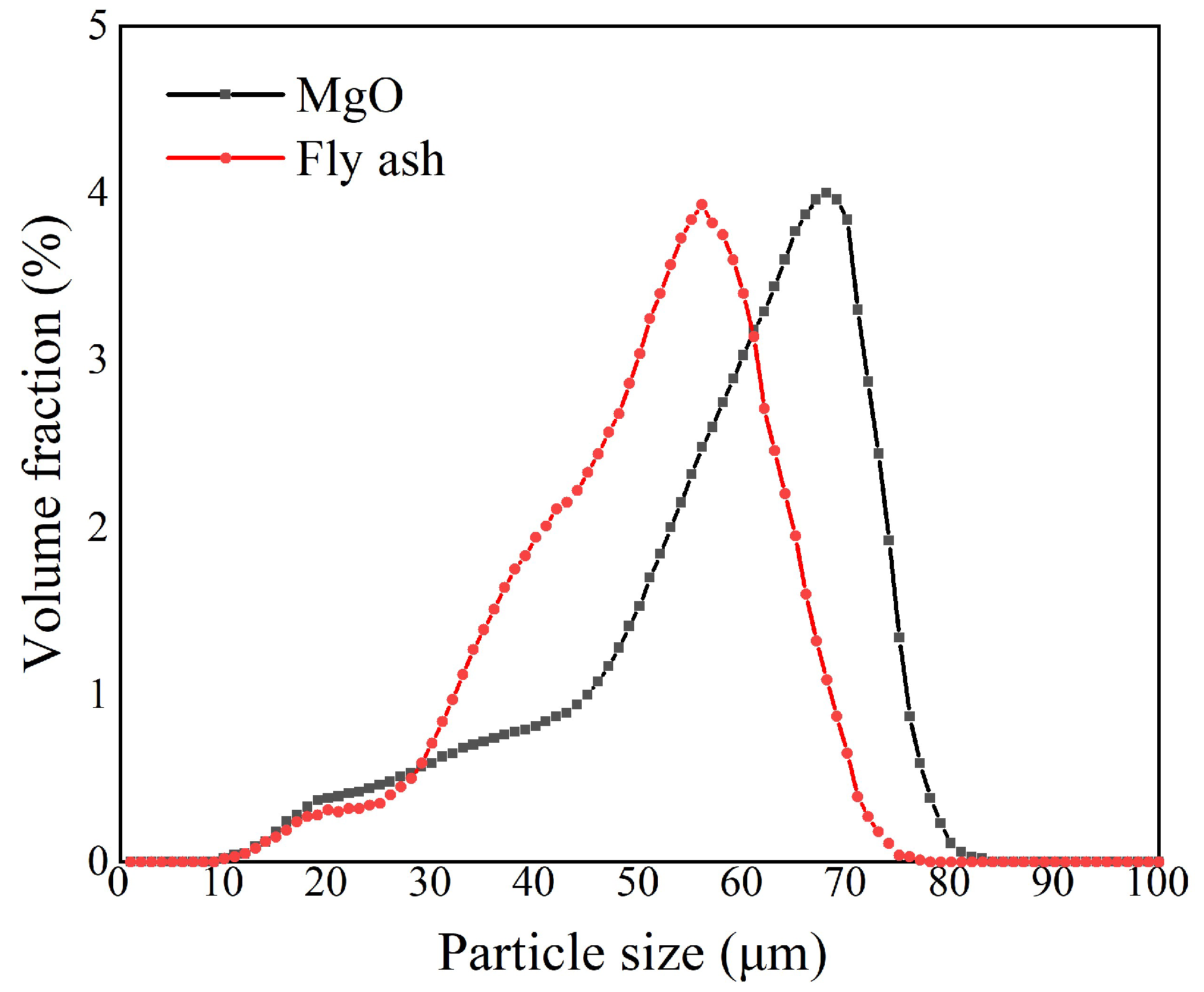

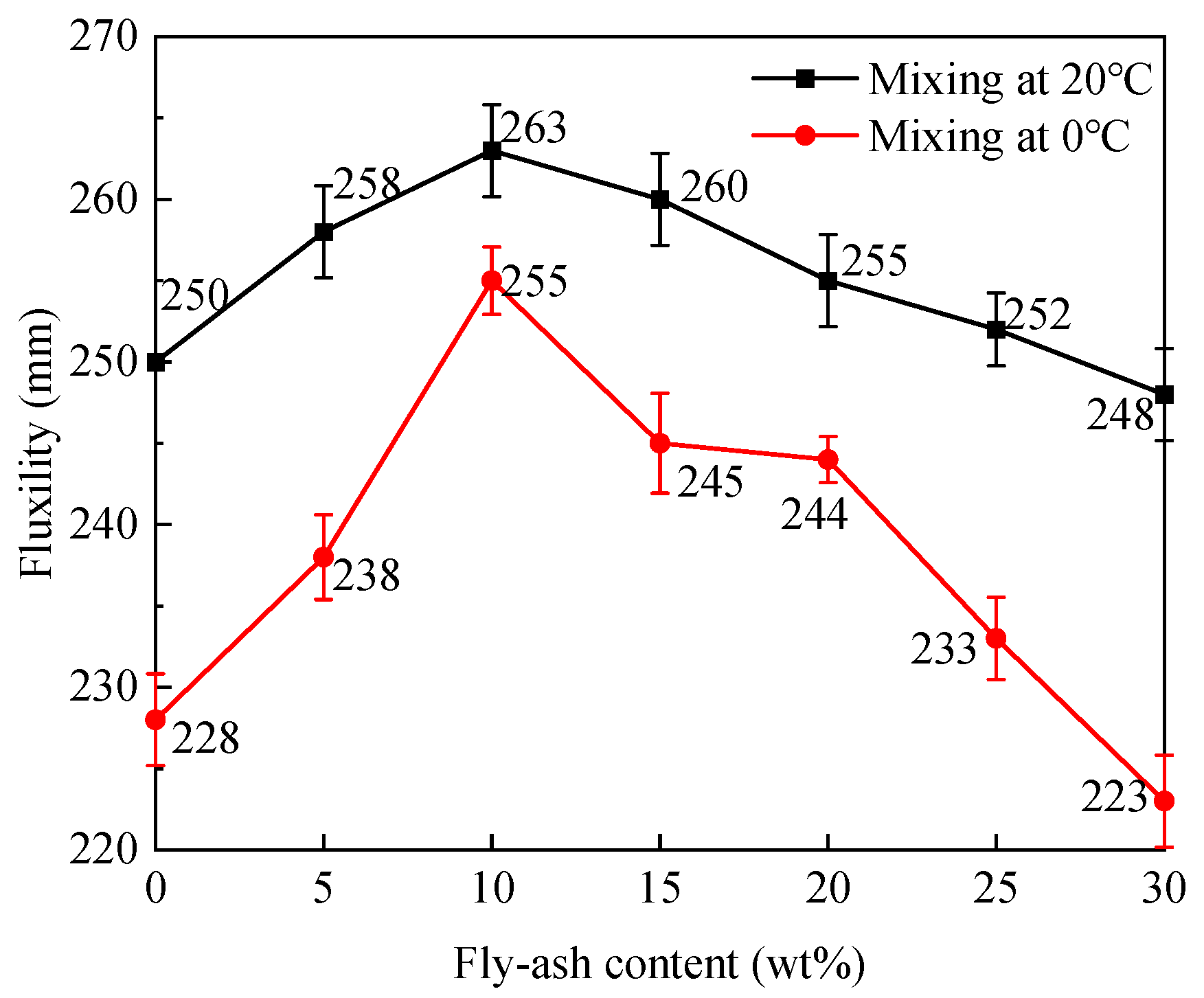
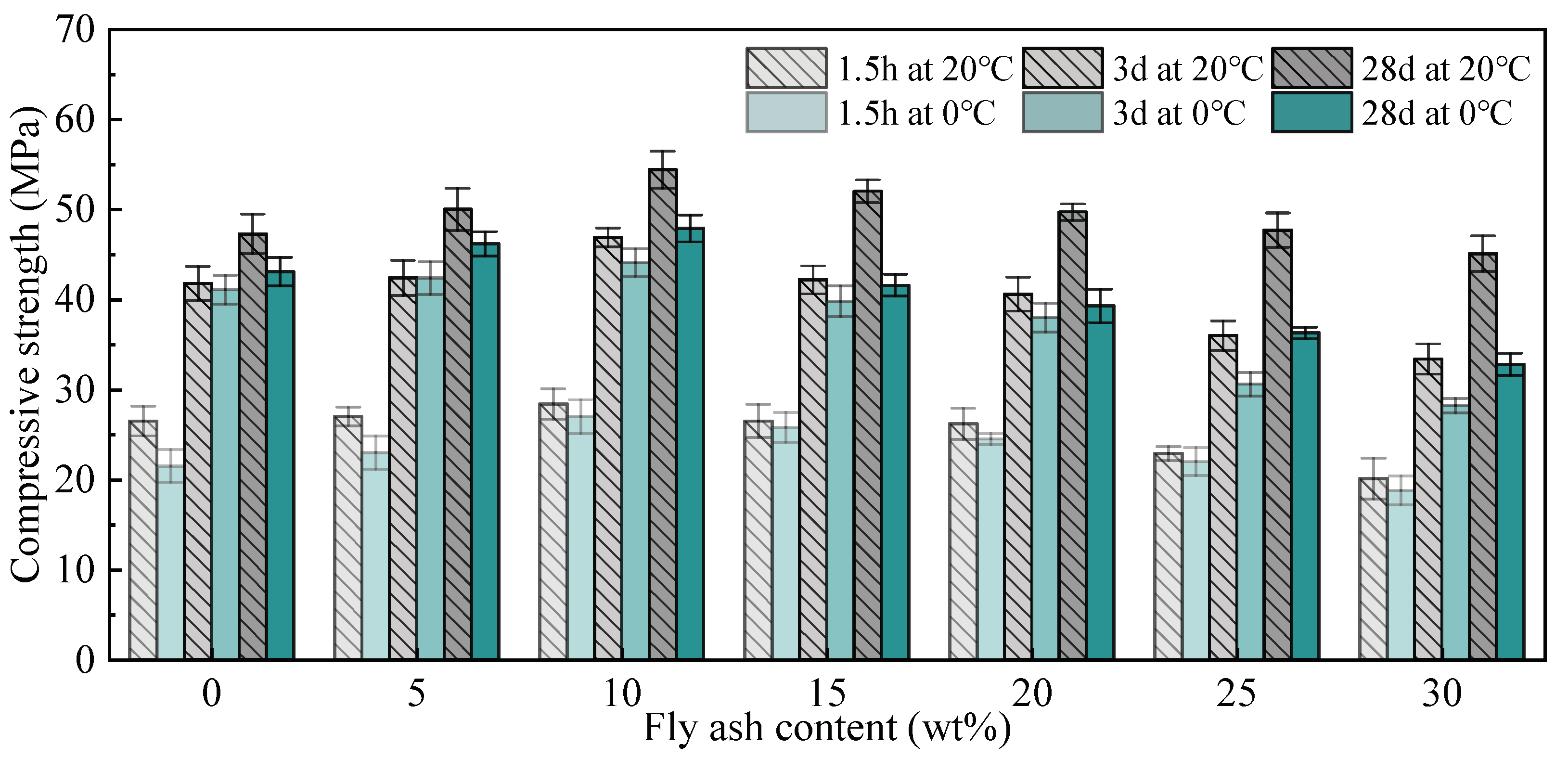
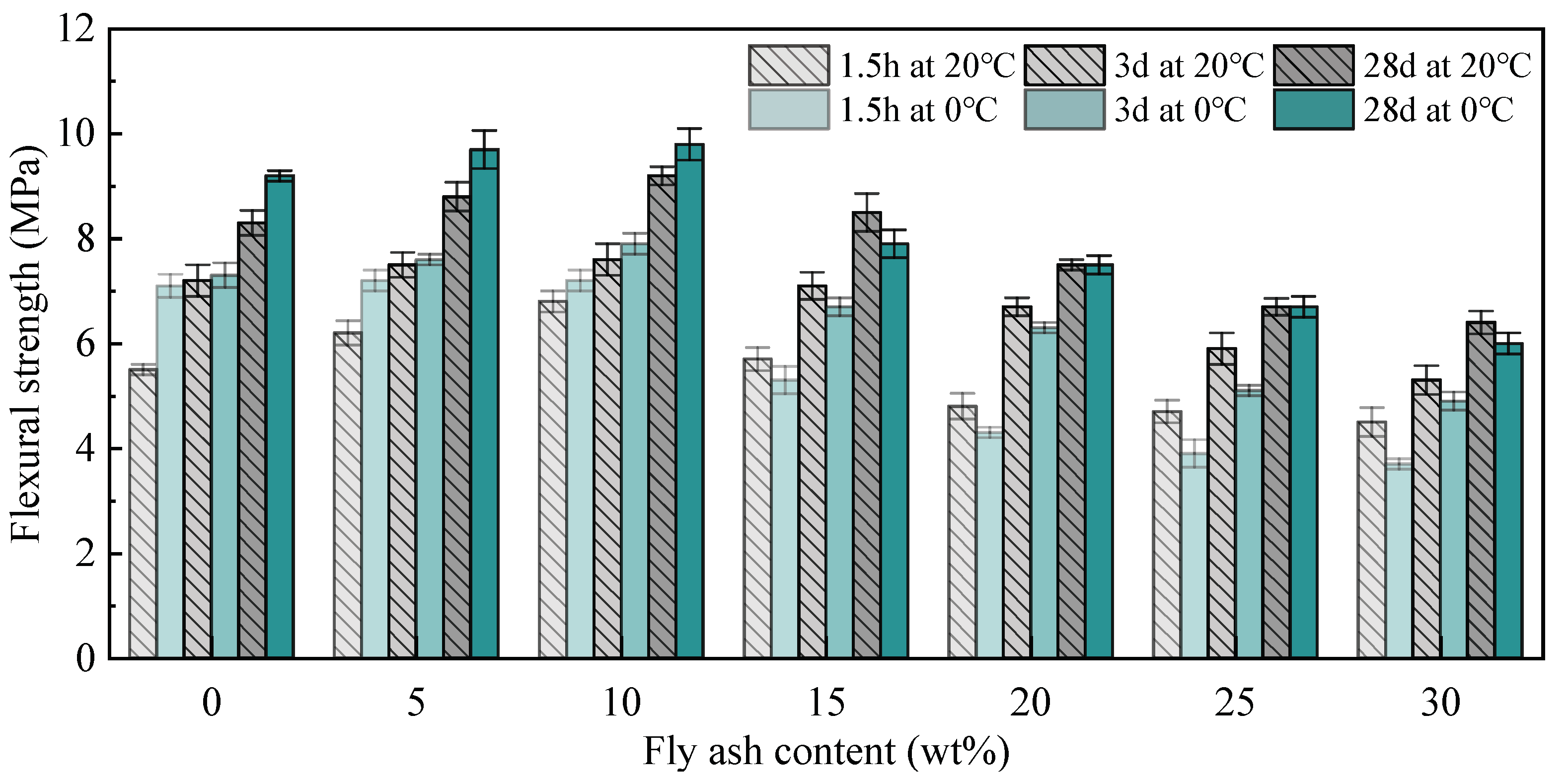

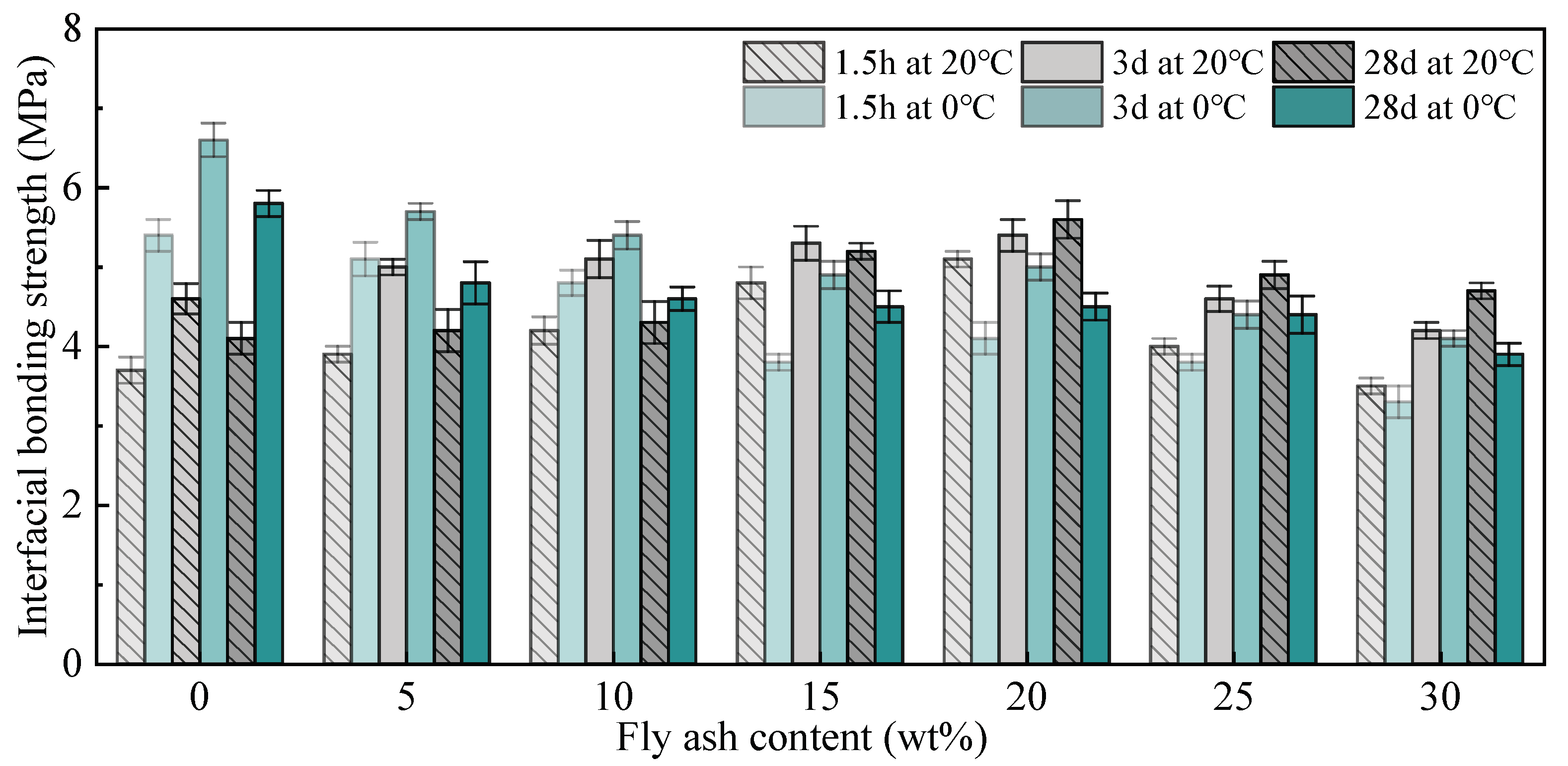
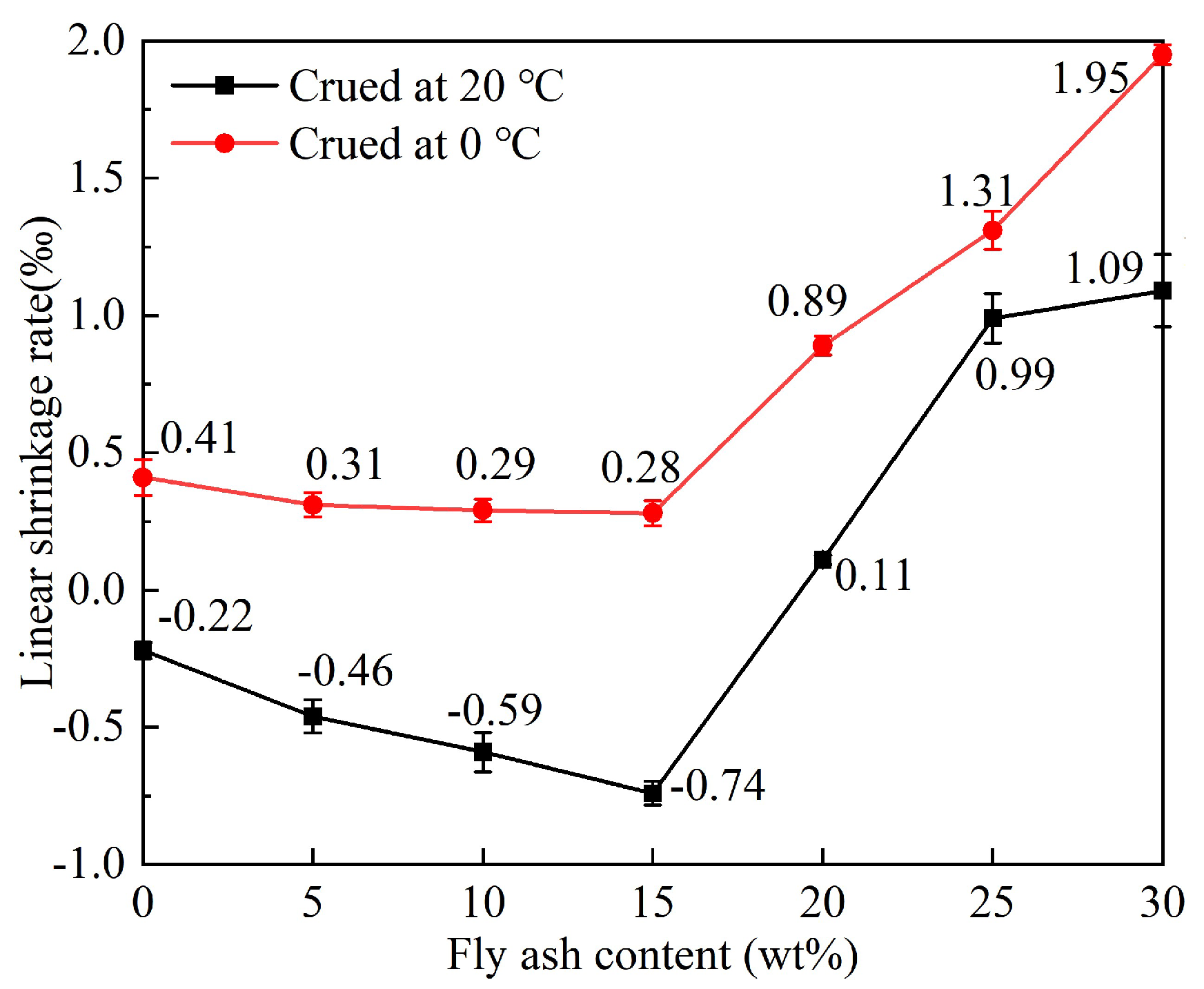

| Raw Materials | MgO | SiO2 | Al2O3 | Fe2O3 | CaO | K2O | SO3 | TiO2 | P2O5 |
|---|---|---|---|---|---|---|---|---|---|
| MgO | 91.46 | 2.03 | 1.02 | 1.27 | 1.75 | 0.04 | 0.20 | 0.04 | 0.13 |
| Fly ash | 0.57 | 34.54 | 21.18 | 3.42 | 3.06 | 1.53 | 0.21 | 0.94 | 0.18 |
| Mixture ID | M + P(wt%) | Fly Ash (wt%) | M/P | W/B | N/M (wt%) | S/B | T/B (wt%) |
|---|---|---|---|---|---|---|---|
| FA0 | 100 | 0 | 2/1 | 0.20 | 12 | 1 | 3 |
| FA5 | 95 | 5 | 2/1 | 0.20 | 12 | 1 | 3 |
| FA10 | 90 | 10 | 2/1 | 0.20 | 12 | 1 | 3 |
| FA15 | 85 | 15 | 2/1 | 0.20 | 12 | 1 | 3 |
| FA20 | 80 | 20 | 2/1 | 0.20 | 12 | 1 | 3 |
| FA25 | 75 | 25 | 2/1 | 0.20 | 12 | 1 | 3 |
| FA30 | 70 | 30 | 2/1 | 0.20 | 12 | 1 | 3 |
Disclaimer/Publisher’s Note: The statements, opinions and data contained in all publications are solely those of the individual author(s) and contributor(s) and not of MDPI and/or the editor(s). MDPI and/or the editor(s) disclaim responsibility for any injury to people or property resulting from any ideas, methods, instructions or products referred to in the content. |
© 2022 by the authors. Licensee MDPI, Basel, Switzerland. This article is an open access article distributed under the terms and conditions of the Creative Commons Attribution (CC BY) license (https://creativecommons.org/licenses/by/4.0/).
Share and Cite
Liu, J.; Yuan, M.; Hai, R.; Yang, F.; Zhang, J.; Li, A. Investigation of the Mechanical Physical Properties of Fly Ash Modified Magnesium Phosphate Cement Repair Mortar Cured at Varying Temperatures. Buildings 2023, 13, 88. https://doi.org/10.3390/buildings13010088
Liu J, Yuan M, Hai R, Yang F, Zhang J, Li A. Investigation of the Mechanical Physical Properties of Fly Ash Modified Magnesium Phosphate Cement Repair Mortar Cured at Varying Temperatures. Buildings. 2023; 13(1):88. https://doi.org/10.3390/buildings13010088
Chicago/Turabian StyleLiu, Junxia, Mengtian Yuan, Ran Hai, Fei Yang, Jingyu Zhang, and Anbang Li. 2023. "Investigation of the Mechanical Physical Properties of Fly Ash Modified Magnesium Phosphate Cement Repair Mortar Cured at Varying Temperatures" Buildings 13, no. 1: 88. https://doi.org/10.3390/buildings13010088
APA StyleLiu, J., Yuan, M., Hai, R., Yang, F., Zhang, J., & Li, A. (2023). Investigation of the Mechanical Physical Properties of Fly Ash Modified Magnesium Phosphate Cement Repair Mortar Cured at Varying Temperatures. Buildings, 13(1), 88. https://doi.org/10.3390/buildings13010088





